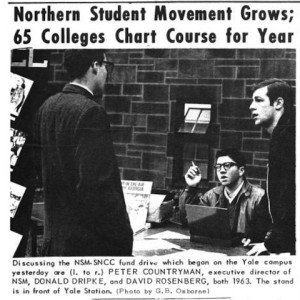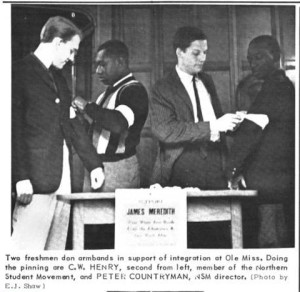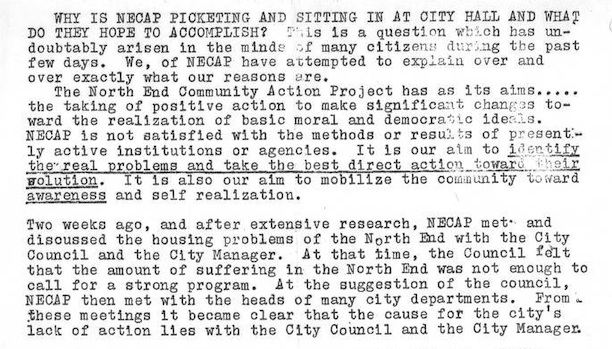by Andy Piascik
College students were an integral part of the upheaval of the 1960s. Motivated by the lunch counter sit-ins in 1960, college students around the country rallied to the cause of justice and freedom. One of the key organizations of the time, the Northern Student Movement (NSM), was founded in Connecticut by students and former students affiliated with Yale University.
New Haven Origins of the Northern Student Movement

Discussing the NSM-SNCC fund drive which began on the Yale campus are (l. to r.) Peter Countryman, executive director of the NSM, Donald Dripke, and David Rosenberg, 1963… (Photo by G. B. Osborne) – Yale Daily News, no. 40, November 9, 1962
The driving force behind the founding of the Northern Student Movement (formed in the fall of 1961) was Peter Countryman, a Yale undergraduate. The organization’s mission was to support the work of the Student Nonviolent Coordinating Committee (SNCC) in the South and to challenge racial discrimination in the North. Though only 19, Countryman had already been active in the civil rights movement through the New England Student Christian Movement. He eventually moved to Philadelphia and established an NSM tutoring program there.
Soon after its founding, the NSM staged its first action, together with the New Haven chapter of the Congress of Racial Equality (CORE), when the two groups held a demonstration protesting local housing discrimination. Initially, the NSM’s membership was primarily white. Over the next several years, however, the group recruited a large number of blacks from college campuses and the communities where it established programs.
As the NSM grew, it established a tutoring program in which students and recent graduates from Yale and other local colleges worked to tutor young people enrolled in New Haven’s public schools. The effort proved extremely successful and the NSM went on to establish similar programs in other cities throughout the Northeast. By 1963, the group consisted of over 2,000 students from dozens of colleges around the Northeast tutoring an estimated 3,500 children. The NSM also began publishing Freedom North, filled with articles about its work and that of the black freedom movement as a whole.
NSM Work in Hartford
In June of 1963, NSM members (primarily from Trinity College) established a tutoring program in Hartford. Instructors held the sessions in churches and other public facilities in or near the neighborhoods where the grade school students lived. The tutoring program became very popular and the Hartford NSM soon branched out with classes in black history and the arts, forums on police brutality and civil rights activities in the South, as well as a newspaper, the North End Voice. Simultaneously, NSM members established the North End Community Action Project (NECAP) that organized protests against discriminatory hiring practices.
In New Haven, NSM members traveled South to participate in the Freedom Rides, voter registration efforts, and Freedom Summer in Mississippi. One NSM member, Yale graduate student Bruce Payne, was shot and wounded in Mississippi by opponents of the voter registration campaign. After a visit to Yale in 1962, Reverend Martin Luther King Jr. wrote of the work of the NSM to William Sloane Coffin, Yale’s chaplain and an NSM supporter, acknowledging that he was “really heartened by the movement in the right direction I sense at Yale.”

Two freshman don armbands in support of integration at Ole Miss. Doing the pinning are C. W. Henry, second from left, member of the Northern Student Movement, and Peter Countryman, NSM director. (Photo by E. J. Shaw) – Yale Daily News, no. 13, October 3, 1962
In addition to New Haven and Hartford, the NSM had vibrant chapters on many campuses and in numerous northern cities, including New York, Detroit, and Philadelphia. In 1963, the group moved its main office from New Haven to New York City and William Strickland, an African American graduate of Harvard, became its executive director.
Black Power
During the 1960s, many in the NSM grew critical of what they saw as the limitations of a movement predicated on “civil rights.” Blacks in the NSM, like blacks in the SNCC, began to call for a focus on Black Power and saw the need to create all-black groups to better achieve that goal. While advocates of Black Power recognized the accomplishments and dedication of white NSM members, many felt that blacks really needed to be the ones determining what their communities needed. Rather than continuing to provide services to a predominantly black constituency, black leaders asked whites to leave the NSM and SNCC and organize the broader white community to, among other things, support the black freedom movement.
Among the NSM’s last significant efforts were a national conference of black students held in Philadelphia and the Black People’s Unity Movement, which organizers designed to attract black professionals to its cause. The chapters in New Haven and Hartford remained active for several more years but dispersed by decade’s end, along with the NSM as a whole. During its life, however, the accomplishments of the NSM attracted many young people in Connecticut, and its efforts still continue to inspire social activists to this day.
Bridgeport native Andy Piascik is an award-winning author who has written for many publications and websites over the last four decades. He is also the author of two books.









